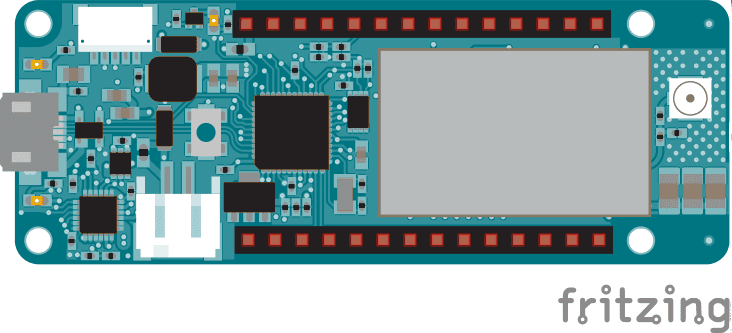GSM Udp NTP Client
In this example, you will use your MKR GSM 1400, to query a Network Time Protocol (NTP) server. In this way, your board can get the time from the Internet.
Hardware Required
antenna
SIM card enable for Data
Circuit

Code
/*
Udp NTP Client
Get the time from a Network Time Protocol (NTP) time server
Demonstrates use of UDP sendPacket and ReceivePacket
For more on NTP time servers and the messages needed to communicate with them,
see http://en.wikipedia.org/wiki/Network_Time_Protocol
created 4 Sep 2010
by Michael Margolis
modified 9 Apr 2012
by Tom Igoe
modified 6 Dec 2017 ported from WiFi101 to MKRGSM
by Arturo Guadalupi
This code is in the public domain.
*/
#include <MKRGSM.h>
#include "arduino_secrets.h"
// Please enter your sensitive data in the Secret tab or arduino_secrets.h
// PIN Number
const char PINNUMBER[] = SECRET_PINNUMBER;
// APN data
const char GPRS_APN[] = SECRET_GPRS_APN;
const char GPRS_LOGIN[] = SECRET_GPRS_LOGIN;
const char GPRS_PASSWORD[] = SECRET_GPRS_PASSWORD;
unsigned int localPort = 2390; // local port to listen for UDP packets
IPAddress timeServer(129, 6, 15, 28); // time.nist.gov NTP server
const int NTP_PACKET_SIZE = 48; // NTP time stamp is in the first 48 bytes of the message
byte packetBuffer[ NTP_PACKET_SIZE]; //buffer to hold incoming and outgoing packets
// initialize the library instance
GSMClient client;
GPRS gprs;
GSM gsmAccess;
// A UDP instance to let us send and receive packets over UDP
GSMUDP Udp;
void setup()
{
// Open serial communications and wait for port to open:
Serial.begin(9600);
while (!Serial) {
; // wait for serial port to connect. Needed for native USB port only
}
Serial.println("Starting Arduino GPRS NTP client.");
// connection state
bool connected = false;
// After starting the modem with GSM.begin()
// attach the shield to the GPRS network with the APN, login and password
while (!connected) {
if ((gsmAccess.begin(PINNUMBER) == GSM_READY) &&
(gprs.attachGPRS(GPRS_APN, GPRS_LOGIN, GPRS_PASSWORD) == GPRS_READY)) {
connected = true;
} else {
Serial.println("Not connected");
delay(1000);
}
}
Serial.println("\nStarting connection to server...");
Udp.begin(localPort);
}
void loop()
{
sendNTPpacket(timeServer); // send an NTP packet to a time server
// wait to see if a reply is available
delay(1000);
if ( Udp.parsePacket() ) {
Serial.println("packet received");
// We've received a packet, read the data from it
Udp.read(packetBuffer, NTP_PACKET_SIZE); // read the packet into the buffer
//the timestamp starts at byte 40 of the received packet and is four bytes,
// or two words, long. First, esxtract the two words:
unsigned long highWord = word(packetBuffer[40], packetBuffer[41]);
unsigned long lowWord = word(packetBuffer[42], packetBuffer[43]);
// combine the four bytes (two words) into a long integer
// this is NTP time (seconds since Jan 1 1900):
unsigned long secsSince1900 = highWord << 16 | lowWord;
Serial.print("Seconds since Jan 1 1900 = " );
Serial.println(secsSince1900);
// now convert NTP time into everyday time:
Serial.print("Unix time = ");
// Unix time starts on Jan 1 1970. In seconds, that's 2208988800:
const unsigned long seventyYears = 2208988800UL;
// subtract seventy years:
unsigned long epoch = secsSince1900 - seventyYears;
// print Unix time:
Serial.println(epoch);
// print the hour, minute and second:
Serial.print("The UTC time is "); // UTC is the time at Greenwich Meridian (GMT)
Serial.print((epoch % 86400L) / 3600); // print the hour (86400 equals secs per day)
Serial.print(':');
if ( ((epoch % 3600) / 60) < 10 ) {
// In the first 10 minutes of each hour, we'll want a leading '0'
Serial.print('0');
}
Serial.print((epoch % 3600) / 60); // print the minute (3600 equals secs per minute)
Serial.print(':');
if ( (epoch % 60) < 10 ) {
// In the first 10 seconds of each minute, we'll want a leading '0'
Serial.print('0');
}
Serial.println(epoch % 60); // print the second
}
// wait ten seconds before asking for the time again
delay(10000);
}
// send an NTP request to the time server at the given address
unsigned long sendNTPpacket(IPAddress& address)
{
//Serial.println("1");
// set all bytes in the buffer to 0
memset(packetBuffer, 0, NTP_PACKET_SIZE);
// Initialize values needed to form NTP request
// (see URL above for details on the packets)
//Serial.println("2");
packetBuffer[0] = 0b11100011; // LI, Version, Mode
packetBuffer[1] = 0; // Stratum, or type of clock
packetBuffer[2] = 6; // Polling Interval
packetBuffer[3] = 0xEC; // Peer Clock Precision
// 8 bytes of zero for Root Delay & Root Dispersion
packetBuffer[12] = 49;
packetBuffer[13] = 0x4E;
packetBuffer[14] = 49;
packetBuffer[15] = 52;
//Serial.println("3");
// all NTP fields have been given values, now
// you can send a packet requesting a timestamp:
Udp.beginPacket(address, 123); //NTP requests are to port 123
//Serial.println("4");
Udp.write(packetBuffer, NTP_PACKET_SIZE);
//Serial.println("5");
Udp.endPacket();
//Serial.println("6");
}See Also
GPRS Constructor
GSMClient Constructor
ready()
connect()
write()
endWrite()
read()
peek()
flush()
stop()
Arduino MKR GSM 1400 - Complete product description.
Getting started with the MKR GSM 1400 - Get everything set up in minutes.
MKRGSM library - Your reference for the GSM Library.
MKRGSMExamplesMakeVoiceCall - How to make a voice call with mic and speaker.
MKRGSMExamplesReceiveVoiceCall - The call is received and connected, the number that is calling is shown on serial monitor and then the call is hung up.
MKRGSMExamplesReceiveSMS - How to receive an SMS message.
MKRGSMExamplesSendSMS - How to send an SMS entering number and text through the serial monitor.
MKRGSMExamplesWebServer - A web server that when gets a request from a client sends back the value read on Analog inputs.
MKRGSMToolsTestGPRS - Tries to access the internet over GPRS with supplied APN and credentials.
Last revision 2017/11/29 by AG